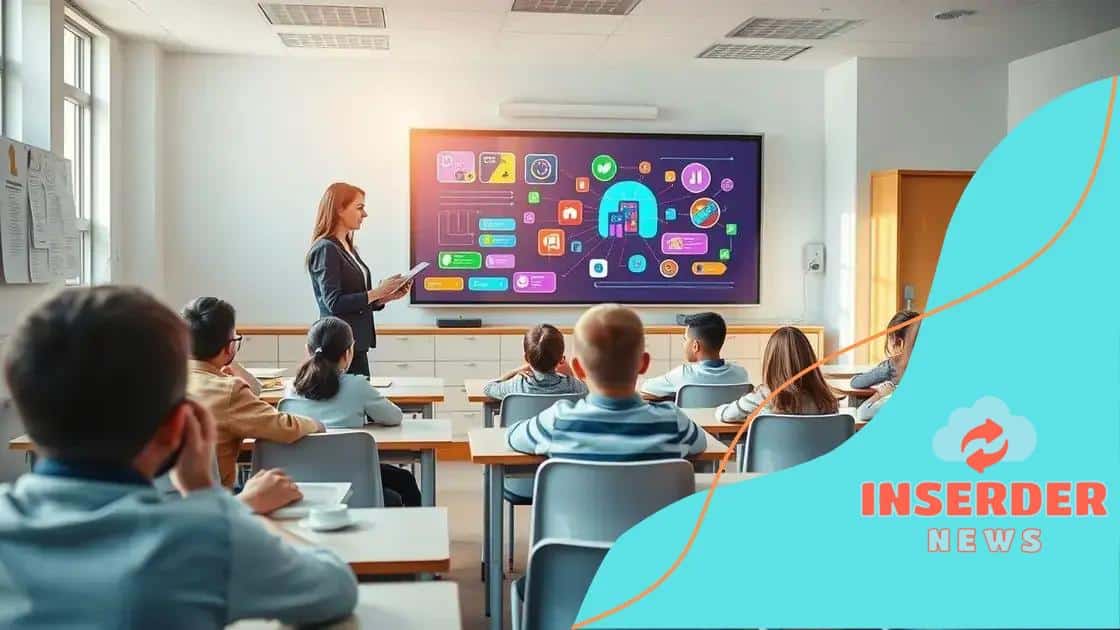How AI is changing teacher-student interactions

AI is changing teacher-student interactions by enhancing communication, personalizing learning experiences, and streamlining assessments, while also addressing challenges like data privacy and the need for educator training.
How AI is changing teacher-student interactions is a fascinating topic that captures the transformation in classrooms. Have you noticed how technology is reshaping learning experiences? Let’s explore how AI is making lessons more engaging and personalized.
Understanding the role of AI in education
Understanding the role of AI in education is vital for anyone involved in teaching and learning. With rapid advancements in technology, artificial intelligence is transforming how knowledge is delivered and acquired. This shift opens doors to new methodologies that enhance both teaching and learning.
AI as a Teaching Assistant
AI can serve as a great teaching assistant, aiding educators in their daily tasks. From grading assignments to managing student records, AI tools can help lighten the workload of teachers, enabling them to focus more on instructional strategies.
Personalizing Learning Experiences
Another crucial role of AI is in personalizing learning experiences for students. By analyzing data from student interactions, AI can provide tailored resources and recommendations, ensuring that each student learns at their own pace.
- Adaptive learning systems adjust to individual student needs.
- AI-powered tools offer real-time feedback.
- Students engage with interactive content specially designed for their learning styles.
Furthermore, the integration of AI in education promotes a growth mindset. When students receive immediate assistance, they are more likely to overcome challenges and pursue deeper knowledge. As such, the role of AI not only enhances academic performance but also cultivates essential skills for the future.
As teachers embrace AI, they also face challenges regarding data privacy and the ethical use of technology. Balancing innovation with these concerns is crucial for fostering a safe learning environment.
In summary, understanding the role of AI in education offers insight into its significant transformations. As this technology continues to evolve, it has the potential to reshape classrooms worldwide, making learning more accessible and efficient.
Personalized learning experiences through AI
Personalized learning experiences through AI are revolutionizing education today. Students have different learning styles, and with the help of artificial intelligence, educators can tailor lessons to meet individual needs.
How AI Adapts to Students
AI analyzes student data, which includes test scores and engagement metrics. This valuable information allows educators to identify where each student excels or struggles. By understanding these patterns, teachers can create customized lesson plans that focus on specific areas.
Benefits of Personalized Learning
Personalization offers several benefits to students:
- Enhanced motivation, as students learn at their own pace.
- Improved comprehension, leading to better academic performance.
- Increased engagement with tailored content that resonates with their interests.
Moreover, AI provides real-time feedback to students. Imagine a scenario where a student struggles with a math problem. AI can recognize the difficulty and offer hints or alternative explanations, making learning more accessible.
In this dynamic learning environment, teachers become facilitators who guide students through their personalized journeys. They can focus on nurturing creativity and critical thinking while AI manages data analysis and resource allocation.
As educational institutions embrace AI, the potential for large-scale personalized learning becomes clearer. Students gain a voice in their educational paths, prompting explosive growth in their academic and personal development.
Enhancing communication between teachers and students

Enhancing communication between teachers and students is essential for a successful learning environment. With the integration of AI tools, this communication is more effective than ever. Artificial intelligence can streamline interactions, making them more meaningful and impactful.
AI Tools for Better Interaction
Many AI platforms offer features that help facilitate communication. These tools help teachers understand their students better by analyzing feedback and participation. By using AI, educators can quickly identify which students may need additional support.
Real-Time Feedback
AI enables real-time feedback, which is crucial in a classroom setting. Instead of waiting for weeks to see grades, students can receive instant responses. This immediate feedback allows them to adjust their learning strategies quickly.
- Teachers can send quick messages to students for clarification.
- Students can ask questions anytime through AI chatbots.
- Assignments can be graded automatically, providing faster insights.
Moreover, AI enhances the ability to communicate outside regular class hours. With platforms that support messaging and video calls, students have more opportunities to connect with their teachers. This flexibility helps to create a stronger support system and encourages students to seek help when needed, fostering a collaborative learning environment.
The shift towards AI-driven communication not only improves relationships but also promotes a sense of community in classrooms. As students feel more connected to their teachers, their overall engagement increases, resulting in better educational outcomes.
AI tools transforming assessments
AI tools transforming assessments are changing how educators evaluate student performance. With the integration of artificial intelligence, grading becomes more efficient and accurate. These tools can analyze student answers and provide insights that traditional methods might miss.
Automated Grading Systems
One major benefit of AI in assessments is automated grading. Instead of spending hours on marking papers, teachers can use AI software to grade multiple-choice questions instantly. This not only saves time but also reduces human error. Moreover, these systems can give instant feedback to students, allowing them to understand their mistakes right away.
Analysis and Insights
AI tools can also provide deeper insights into student performance. By analyzing data trends, educators can see which concepts students struggle with the most. This information allows for timely interventions, ensuring that no student falls behind.
- AI highlights common errors across a class.
- Teachers can gather data on student improvement over time.
- Customized reports can be created for individual learners.
As these assessments become more sophisticated, they adapt to the needs of students. For example, adaptive testing adjusts the difficulty of questions based on a student’s previous answers. This method helps keep students engaged while accurately measuring their understanding.
In summary, AI tools are revolutionizing the assessment process by making it faster, more reliable, and responsive to student needs. The power of AI to transform how we assess learning can lead to improved educational outcomes for all students.
Challenges and considerations in AI integration
Challenges and considerations in AI integration are significant as schools adopt these technologies. While the benefits of AI in education are clear, hurdles remain that educators and administrators must address. Understanding these challenges is vital for successful implementation.
Data Privacy Concerns
One major concern is data privacy. With AI systems collecting and analyzing student data, schools must ensure that this information is protected. Parents and students often worry about how their data is used and shared. Establishing clear guidelines for data usage and protection is essential to gain trust.
Training Educators
Another challenge is training educators to use AI tools effectively. Without proper training, teachers may feel overwhelmed by new technology. Continuous professional development and support are necessary to help teachers integrate AI into their classrooms.
- Provide workshops on AI tools.
- Encourage collaboration among teachers.
- Offer resources for ongoing learning.
Furthermore, the cost of implementing AI can be a barrier for many schools. Budget constraints may limit access to the latest technologies and training programs. Schools must find creative solutions to allocate resources for these essential tools.
As schools navigate the integration of AI, they also need to consider the impact on student learning and engagement. It’s essential to assess whether the use of AI truly enhances educational experiences or if it complicates them.
By addressing these challenges proactively, schools can create a more effective learning environment that harnesses the potential of AI while ensuring that students are supported and safeguarded.
FAQ – Frequently Asked Questions about AI in Education
How does AI enhance teacher-student interaction?
AI tools facilitate real-time communication, making it easier for students to ask questions and for teachers to provide support.
What are the benefits of personalized learning through AI?
Personalized learning adjusts the pace and style of teaching to meet individual student needs, leading to improved engagement and understanding.
How can schools ensure data privacy with AI tools?
Schools must implement strict data protection policies and guidelines to safeguard student information when using AI technologies.
What challenges do educators face when integrating AI?
Key challenges include the need for proper training, potential data privacy concerns, and budgeting for technology implementation.






